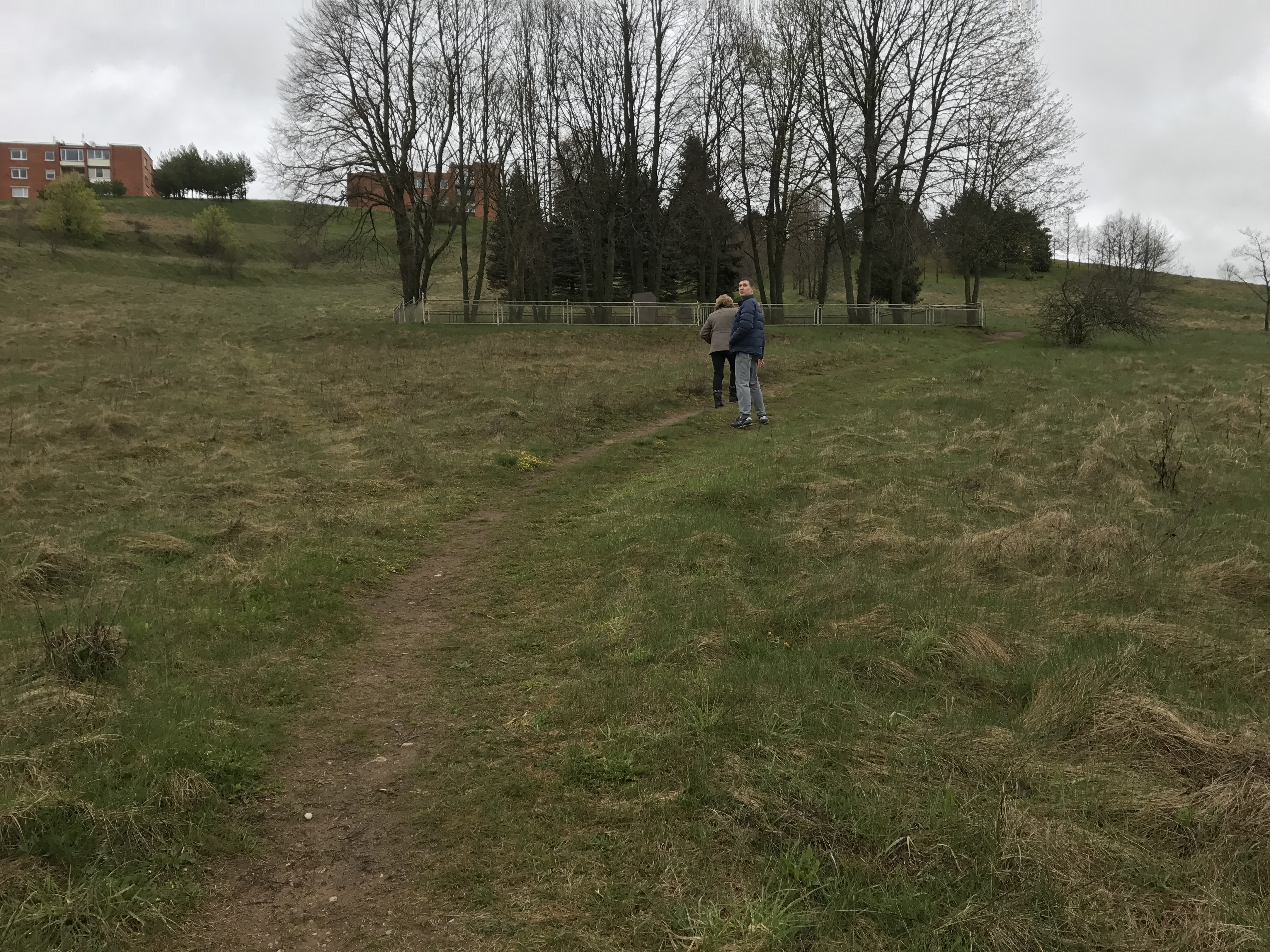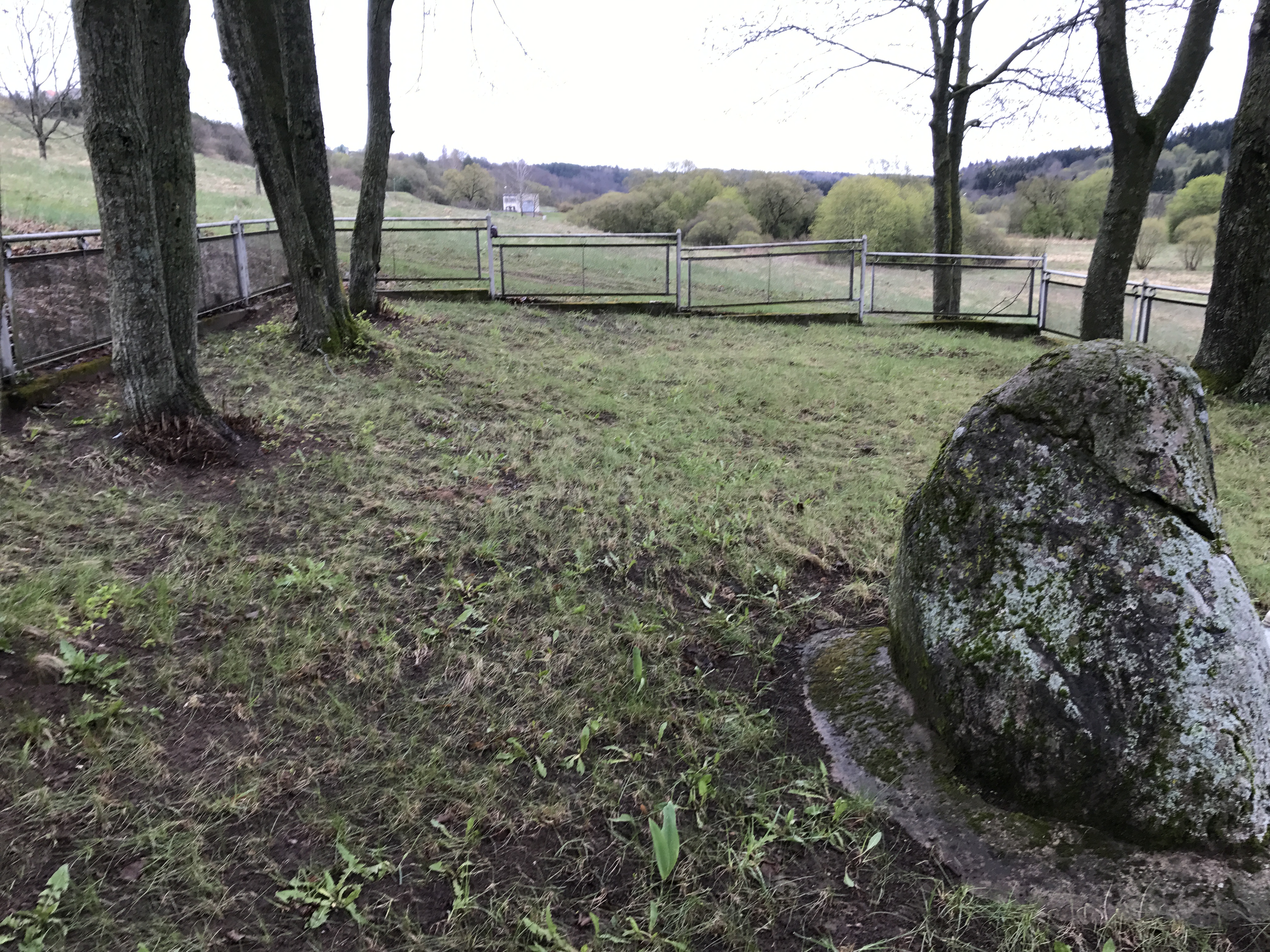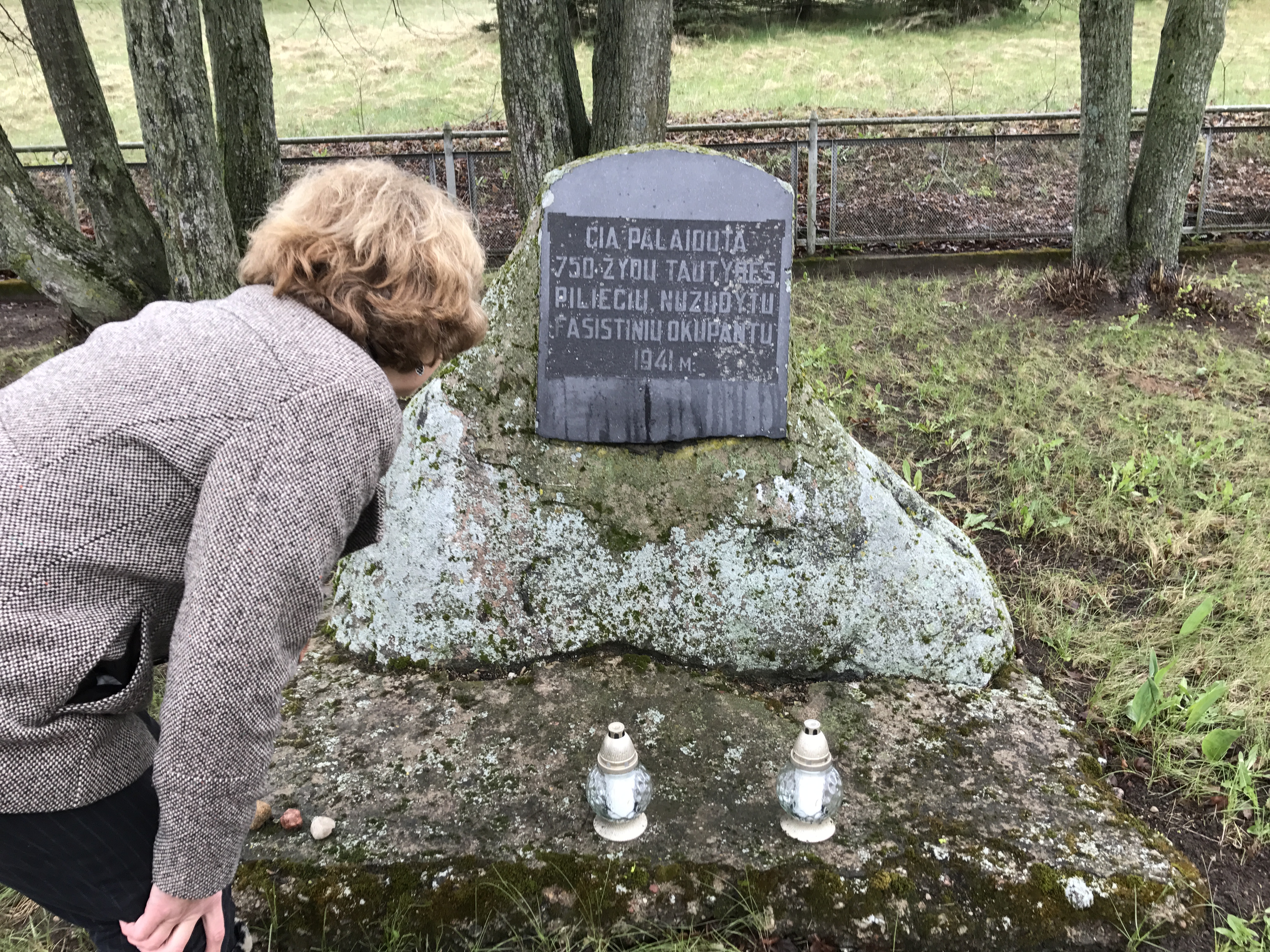Part of Jewish tourism is trying to find or generate the appropriate emotions—sadness, nostalgia, horror, or despair. It was hard for me to do any of this in such a location. The grumpy farmer, the silent high-school teacher, the stolid guide. We turn around and trudge back from the site. As we walk I try to talk with the farmer, but it’s impossible to communicate since neither of us speaks the other’s language. I ask Loreta to thank him for showing me the beautiful farm and the cemetery. I’m not sure what she says, but he doesn’t seem to reply. He’s less grumpy now as we head back to his house. As someone who grew up with Deaf parents, I’m fairly good at gesture. I sweep my hand around the countryside and nod approvingly. He relaxes a bit as if he understands I like his place. We pass by beehives, and I make the universal sound for bee—the buzz–. He vaguely smiles, and I try to let him know that I too have had beehives. He tells Loreta that he is a hobbyist not a real beekeeper. By the time we reach the gate, we all shake hands and for some unaccountable reason, as I am shaking his hand, I hug him. He seems a bit uncertain, and then he hugs me. I feel a swell of emotion I can’t place. Something about his ancestors killing mine, but here we are—alive, in the beautiful countryside, just fellow humans. The trip I’ve taken to get here, and the remote place he lives in, somehow converge. It takes me a few moments to recompose myself. I look down and see a carpet of rue flowers—symbols of repentance.
Then back in the car. We again almost swimming along muddy winding roads, swerving and twisting in the muck. And now we arrive at the killing site. It is about three-quarters of the way up a sloping hill from the river. It is another bucolic field, this one with a small cluster of trees reaching skyward.

Until the government demanded that such sites be memorialized, the cows grazed here. Two humble markers now have been erected. One in Lithuanian, the other in Hebrew—the former in metal and the later a small marble plaque mounted on an ancient moss-covered stone that perhaps was taken from the Jewish cemetery. The whole area, about 200 feet by 50 feet, has a low, functional chain-link fence around it. It is hard to imagine that 700 people—men women and children—were buried here.
Victor tells me that the week before his students had done The March of Death. It involved them tracing the walk the Jews took to the killing pit. Each student had a stone with the name of a Jew who was killed. The stones are now piled up next to the memorial markers.
According to one source, this is what happened when the Germans entered Ariogala:
“On June 23, 1941, one day after the Germans invaded the Soviet Union, a reconnaissance unit of the German army entered Ariogala. But it was the Lithuanian nationalists who took control of the town. They embarked on a killing spree, brutally persecuting their Jewish neighbors. Among their first victims were Zvi Ziv, Michael Kaganovitz and Yoseph Markovitz. Then they assembled all the Jews in a confined area between the synagogue and the Beit Midrash. This area was enclosed by a wire fence and dubbed a “Ghetto”. From here every day they took Jews for forced labor while torturing and beating them. The scholar, Ya’akov Kastin, author of the book “Mishpat Ya’akov”, was also among the miserable Jews.
One day, all the Jews were ordered to move to another place. They were promised that they would work in the new place until the end of the war. Each person was allowed to take whatever he or she was able to carry. As the transfer approached, Jews from the nearby towns of Cekiske and Veliuona were also brought there. The Jewish men, women, elderly and children, accompanied by armed Lithuanian police, were led to the flourmill on the bank of the Dubysa River. As they got close to the river, the Lithuanian policemen opened fire from a distance of 5-6 meters and murdered all of them. The murdered were thrown into a pit 50-60 meters long that was dug in advance. According to a German source (The Jager Report), 207 men, 260 women and 195 children were murdered there between August 28 and September 2, 1941. In 1961, in a trial conducted by the Soviet authorities, one of the participants in the killings said that all of the people who participated in the killings, among which were the school’s teachers and the local priest, were invited afterwards to the municipality for a festive meal accompanied by plenty of drinks.[1]”
More details were added by the Victor and Loreta. As in so many other places, healthy Jewish men were the ones who dug the pit without knowing why. They, like everyone else, ended up in the pit. The Christian townspeople were told to stay in their houses at a certain hour and to shutter the windows that faced the river. One bullet per Jew was costly, so babies were, so they said, picked up by their legs and smashed against a tree or a rock.

I consider all this as I stand under this copse of trees in this painfully lovely sloping field. I understand, but how to feel? This is the challenge of Jewish tourism. The enormity of the deed, its brutality and inhumanity, the sheer numbers in this small town multiplied by the next town and the next adding up to 136,000 Jews in a few months of a summer. I ask Loreta and the high-school teacher to let me have a moment. She says, of course. They descend to the river’s edge by the car. I am alone with the history of despair and the physical space that now looks so ordinary, despite a few markers.

My first impulse is to pee. I’ve been driving and walking for hours. I’m used to doing so in the outdoors at my country house in Delaware County, New York, which looks so much like this place. When I leave my property or arrive, I feel the urge to urinate. It’s some primitive impulse to claim a place, mark it like a dog. I would claim this sacred and monstrous place as somewhere I have been, left my mark, been marked by it. Then I’m struck by the desecration that such an action would be. I have an Italian friend whose father, a bitter man, would always say as an insult “I’ll piss on your grave.” So of course, I do what civilized people do, I repress the desire. The act of being civilized, of holding back, seems appropriate in this place of excess.
The Nazis didn’t have a master plan at this point. They had just entered Lithuania in their invasion to drive out the two groups they hated the most—Communists and Jews. In their mind these were one in the same. The orders were unclear—who issued them, where did they come from? But the intent was there—have the locals kill the Jews. This was part of a vision of a cleansed greater Germany. The locals, on their part, had lived with the Jews in Ariogala since the 18th century, although Jews had been in Lithuania since the 13th century. For more than 500 years Jews had been merchants, tailors, artisans, moneylenders and the like. But local tradition held that Jews were rich, clever, selfish, and evil. The story we have all heard as a kind of fantasy—that Jews would steal Christian babies and use their blood to make matzohs—was here actually held to be true. In Ariogala in the 19th century Jews were abducted and killed for this very reason. In Italy I have seen a beautiful six-scene pradella by Paolo Uccello that shows a Jew stealing the Eucharist and cutting into it. The host bleeds a stream of blood that flows to the street and alerts the citizens who save the host and punish the Jew and his family. Such stories were rife throughout Europe. They were not regarded as stories but as truth. Jan T. Gross in his book Neighbors: The Destruction of the Jewish Community in Jedwabne, Poland details how local prejudice against alleged Jewish kidnapping of Christian babies for their blood was one of the “triggers” for the successful Nazi mobilization of the local people to do their dirty work.[2] About 100 cases of Jews being killed, burned en masse, and the like have been documented in the past 800 years. Gross mentions a postwar massacre in Poland based on the same mistaken narrative.
Loreta, a font of information, tells me that in one instance at a nearby town the Christians were lined up in the central square. The Germans asked if anyone didn’t want to engage in the violence to be perpetrated on the Jews. People sheepishly stepped forward asking to be excluded. Instead of being shot, they were permitted to go home. In other words, one could have opted out. It has been documented that not only the worst and the poorest but all classes of Lithuanian society were involved directly, including priests and professionals. Some say that the Nazis realized that the locals would do a messy job or would not follow commands. So they assembled crack brigades of local marksmen and former members of the Russian army. These locals were the ones who went from town to town to do the heinous work.
My act of imagination as I stand alone in the killing pit. What was it like for my Jews? Did they know? Did they fear? If one bolted for the river, it was clear that person would be shot. If they walked quietly to the pit, well, execution by bullet as well. Does one reconcile with one’s fate? Trembling, cold, helpless? I have heard also that victims were made to undress so that their clothing and possessions could be used by the perpetrators. Now naked, shivering, embarrassed. The women in front of the men. Skinny, circumcised men, bony and frail standing on the edge of the pit waiting for the bullet of execution. Or could it now be salvation?
But then the shooters. Another act of imagination. How was that done. Hundreds of murders each day. The disgust of the pits of bodies. Apparently some of them were drunk while doing the work. The Germans provided more vodka to those who shot. An interview with one of these shooters is strangely unrevealing. He said, you drank vodka and pulled the trigger. The person fell down. Apparently you could get used to it. And at night, after all was done, the spoils were distributed. The Germans getting the gold and jewelry. The locals getting things of lesser value–entering the Jewish homes and taking silverware, plates, and linens. Loreta tells me that even today the villagers of Ariogala retain these items. The ones who lived through the horror are now almost all dead. The next generation keeps silence, and the silverware. Loreta tells me that one of her tourists from Australia, not a Jew, remembers that her father, who had been one of the killers, became a dark and troubled man down under. He didn’t talk, drank much, and died early. No one can protect humans from the consequences of their action. Like an invasive acid the memory must (must it not?) corrupt the being eroding its core. What a price was paid on all sides?
I stood there thinking such things. And although I was moved, I wasn’t that moved. I wasn’t moved in proportion to the karmic impact of that place. I left the confines of the chain-link fence and began to head down the hill toward the people waiting for me. Loreta was smoking a cigarette. She had told me she smoked one a day, but by the end of the day she had puffed on quite a few more. The effect of telling this story over and over again was perhaps taking its toll on her. Was it pain or ennui? Or both?
I turn back to have a last look. Then it occurs to me to say the Yiskor, the Jewish prayer for the dead. I remembered a couple of lines from my childhood. We children had to leave the temple and go to an anteroom because we did not have dead parents yet. But the lugubrious sound of the chanting remained with me, as it did at funerals. I start saying “Yisgidal, yisgedash….” And I can’t past those two words. My voice cracks, and I well up with tears. This route to sadness and pain had to travel the circuitous route back to my childhood synagogue, the old men and women, the teenagers, the pretty girls, we kids fooling around behind the rabbi’s back. And then back to me now. We, the Jews, the neighbors, the friends—all of us now there underground buried forever in the monstrosity of human torment. It wasn’t they who were killed, standing on the edge of the pit. It was we. It was I.
When I recover a bit, I say the “Shema” the prayer that is said on many occasions but it can be said when one is at the point of one’s own death. I’m sure the Shema was being said by the naked shivering men and women. “Shema yisroel adonai elohanu adonai echad.” It is the touchstone prayer for all Jews, a simple statement about monotheism. “Hear O Israel, the lord our god, the lord is one.” Again it’s hard to finish as I stand there, but this time it feels redemptive. The credo goes on generation to generation, from the dead to the living.
I wipe my eyes, now reddened, and descend to the waiting guides. They have probably seen this before. It is what the Jewish tourist pays to experience, a kind of culmination of the dark tourism experience. I came, I saw, I wept.
***
[1] http://www.jewishgen.org/yizkor/pinkas_lita/lit_00135.html
[2] Jan T. Gross, Neighbors: The Destruction of the Jewish Community in Jedwabne, Poland (Penguin, 2001), 80, 100.

